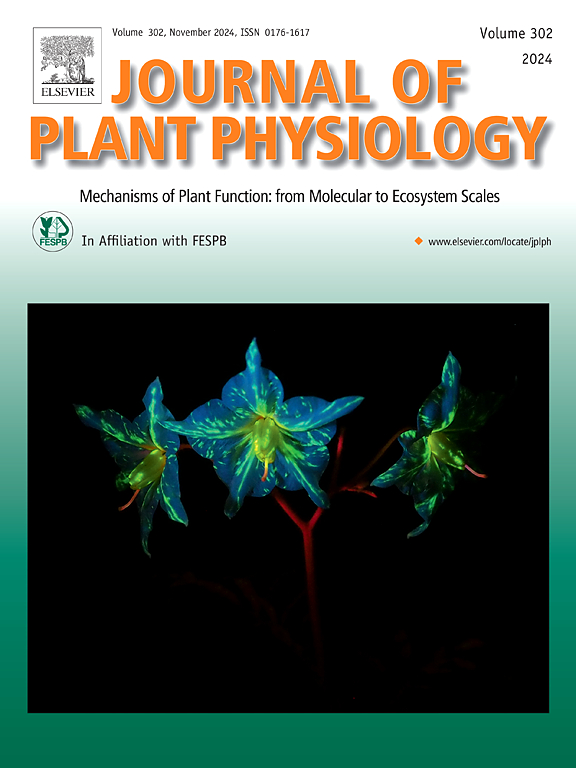Carbon dots promote tomato growth and yield via photosynthesis enhancement and leaf senescence delay
IF 4.1
3区 生物学
Q1 PLANT SCIENCES
引用次数: 0
Abstract
Food security is increasingly threatened by population growth, regional conflicts, and climate disasters, making it imperative to further increase crop production. One safe approach to achieving this goal is to expand the utilization of agricultural inputs. Recent research has revealed that carbon dots (CDs), a class of carbon-based nanomaterials, have potential in interacting with plants to enhance growth. However, the underlying molecular mechanisms remain poorly understood. In this study, we synthesized CDs that emit red light at a wavelength of 670 nm when excited by green light at 560 nm. When tomato seedlings were treated with these CDs via foliar spraying, their plant height increased by 10.26 % and fresh weight by 19.81 %. Measurements of photosynthesis and the Hill reaction showed significant improvements in both photosynthetic efficiency and chloroplast electron transport. Transcriptome analysis of tomato leaves revealed downregulation of genes associated with leaf senescence, including those involved in ethylene response, protein ubiquitination, chlorophyll degradation, ATP hydrolysis, and lignin synthesis. Transient expression assays of phyB1::GFP and phyB2::GFP demonstrated that CDs accelerate the translocation of red light-responsive phytochrome B (PhyB) from the cytoplasm to the nucleus, a process that may contribute to delayed leaf senescence. Additionally, during the harvesting period, CD-treated tomato plants showed evident enhancements in both fruit quantity and quality. These results collectively indicate that CDs promote tomato growth and fruit production by enhancing photosynthesis and delaying leaf senescence. This study not only provides insights for promoting tomato growth and yield but also offers valuable guidance for investigating interactions between nanomaterials and plants.
碳点通过促进光合作用和延缓叶片衰老来促进番茄生长和产量。
粮食安全日益受到人口增长、地区冲突和气候灾害的威胁,因此必须进一步提高作物产量。实现这一目标的一个安全办法是扩大农业投入的利用。最近的研究表明,碳点(CDs)是一类碳基纳米材料,具有与植物相互作用以促进生长的潜力。然而,潜在的分子机制仍然知之甚少。在这项研究中,我们合成了在560nm的绿光激发下发出波长为670 nm的红光的CDs。叶面喷施这些cd处理的番茄苗株高和鲜重分别提高了10.26%和19.81%。光合作用和希尔反应的测量结果表明,光合效率和叶绿体电子传递均有显著改善。番茄叶片转录组分析显示,与叶片衰老相关的基因下调,包括参与乙烯响应、蛋白质泛素化、叶绿素降解、ATP水解和木质素合成的基因。对phyB1::GFP和phyB2::GFP的瞬时表达分析表明,CDs加速了红光响应型光敏色素B (PhyB)从细胞质向细胞核的易位,这一过程可能有助于延缓叶片衰老。此外,在收获期,cd处理的番茄植株在果实数量和品质上都有明显的提高。综上所述,CDs通过促进光合作用和延缓叶片衰老来促进番茄生长和果实产量。该研究不仅为促进番茄生长和产量提供了新的思路,而且为研究纳米材料与植物之间的相互作用提供了有价值的指导。
本文章由计算机程序翻译,如有差异,请以英文原文为准。
求助全文
约1分钟内获得全文
求助全文
来源期刊

Journal of plant physiology
生物-植物科学
CiteScore
7.20
自引率
4.70%
发文量
196
审稿时长
32 days
期刊介绍:
The Journal of Plant Physiology is a broad-spectrum journal that welcomes high-quality submissions in all major areas of plant physiology, including plant biochemistry, functional biotechnology, computational and synthetic plant biology, growth and development, photosynthesis and respiration, transport and translocation, plant-microbe interactions, biotic and abiotic stress. Studies are welcome at all levels of integration ranging from molecules and cells to organisms and their environments and are expected to use state-of-the-art methodologies. Pure gene expression studies are not within the focus of our journal. To be considered for publication, papers must significantly contribute to the mechanistic understanding of physiological processes, and not be merely descriptive, or confirmatory of previous results. We encourage the submission of papers that explore the physiology of non-model as well as accepted model species and those that bridge basic and applied research. For instance, studies on agricultural plants that show new physiological mechanisms to improve agricultural efficiency are welcome. Studies performed under uncontrolled situations (e.g. field conditions) not providing mechanistic insight will not be considered for publication.
The Journal of Plant Physiology publishes several types of articles: Original Research Articles, Reviews, Perspectives Articles, and Short Communications. Reviews and Perspectives will be solicited by the Editors; unsolicited reviews are also welcome but only from authors with a strong track record in the field of the review. Original research papers comprise the majority of published contributions.
 求助内容:
求助内容: 应助结果提醒方式:
应助结果提醒方式:


